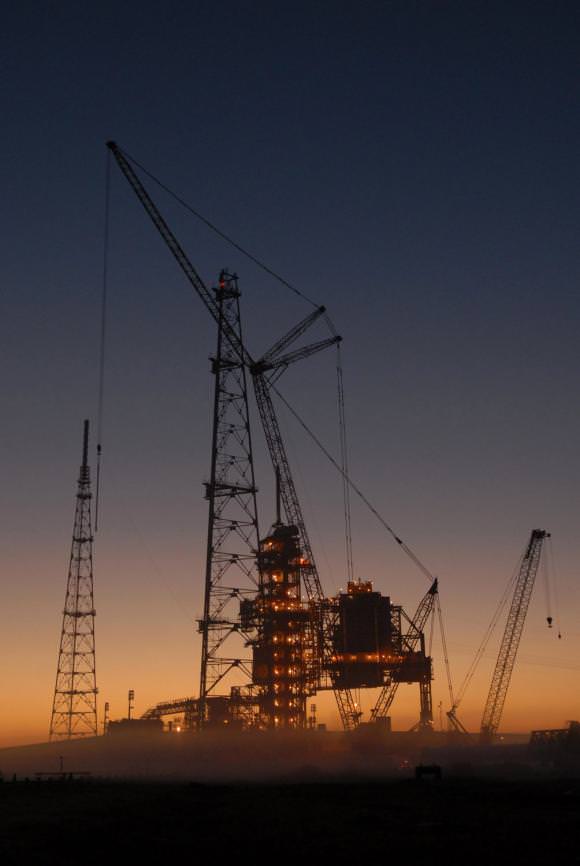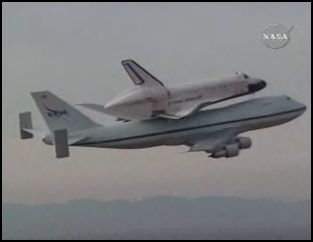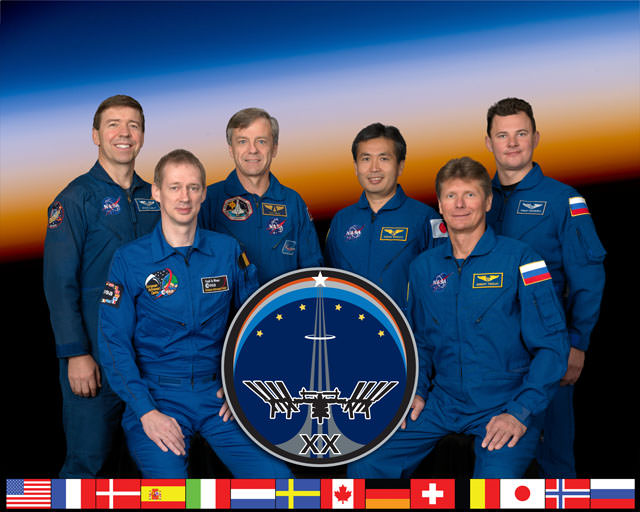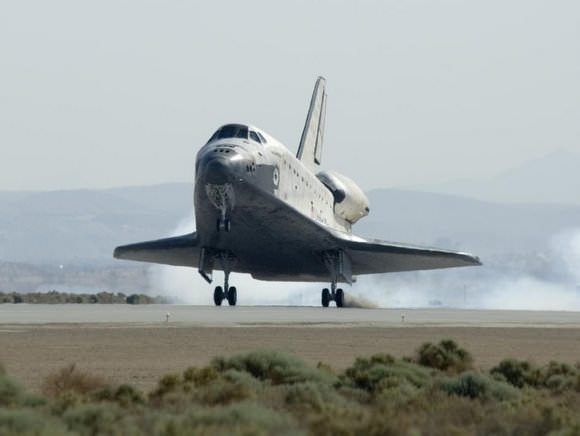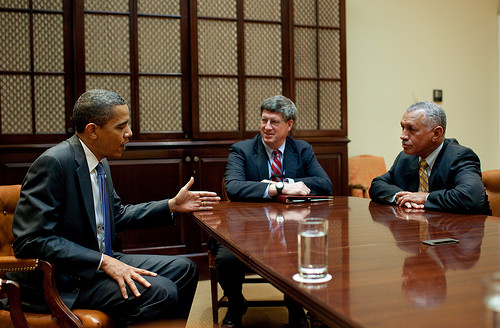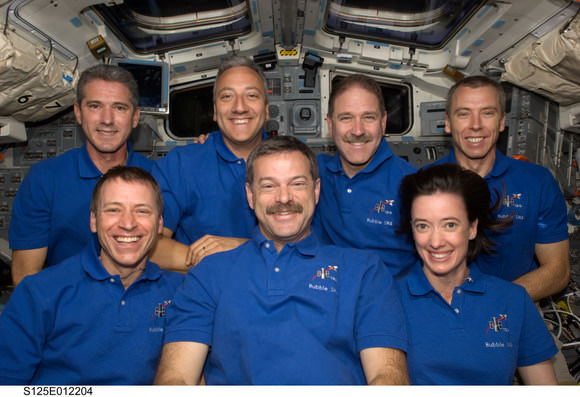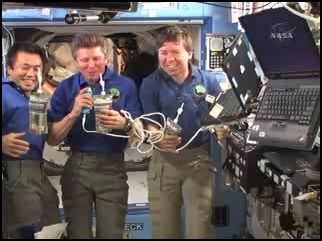Holy Moly! Not to wish anything like this for Saturday’s launch, but I came across this video of the STS-68 launch attempt in 1994 that was aborted at the very last second. Watching it is enough to make your heart stop. Everyone involved must have experienced a tremendous rush followed by extreme let-down! The main engines had lit, but were shut down 1.9 seconds before liftoff when on-board computers detected higher than acceptable readings in a sensor monitoring the discharge temperature of the high pressure oxidizer turbopump in main engine #3. In the history of the shuttle program, five launch attempts were aborted under five seconds from the planned launch. STS-68 came the closest to hauling the mail before being aborted.
Continue reading “What Happens During a Last Second Shuttle Launch Abort”
Company’s Coming! And They’re Bringing the Front Porch
[/caption]
UPDATE: 6/13
Endeavour’s launch has been postponed because of a leak associated with the gaseous hydrogen venting system outside the shuttle’s external fuel tank. The system is used to carry excess hydrogen safely away from the launch pad. Managers scrubbed the launch for at least 96 hours. The earliest the shuttle could be ready to launch is June 17. However, there is a conflict on the Eastern Range that date with the scheduled
launch of the Lunar Reconnaissance Orbiter/Lunar Crater Observation and Sensing Satellite. We’ll keep you posted on when a launch date is set.
Original article:
Space shuttle Endeavour is all set to blast off Saturday morning, June 13 at 7:17 am EDT, heading to the International Space Station. The mission will be jam-packed with five spacewalks for station construction, and Endeavour is bringing up a “front porch” for the ISS. Is adding a porch an attempt to make our orbiting home in space just a little more “homey?” Actually, the porch is a key piece of the Japanese laboratory, Kibo. And the ISS itself will be jam-packed, too as the newly expanded six-member ISS crew will welcome the seven-member shuttle crew – a record number of astronauts to be on board the station at one time.
On Friday morning the Rotating Service Structure was removed from around Endeavour, and all indications are good for an on-time liftoff Saturday. The weather looks to be about 90% “go,” and the shuttle processing has been smooth in preparations for launch.
“We’re in really good shape to fly,” said Mike Moses, director of shuttle integration at the Kennedy Space Center. “The team carefully reviewed the spacecraft to make sure nothing was overlooked since the launch comes only a few weeks after the end of the STS-125 Hubble repair mission.
Moses said having the big crew on the station could be an interesting time. “It’s like having your family descend on you for the holidays, right? And they’re going to stay for a very long time. And they come, and they’re bringing all their stuff.”
But he said the combined crews are more than ready for the challenge. “I think what we’re going to see is probably some unprecedented efficiencies because they all know where to go, they know what the procedures are, they know how to get things done,” he said.
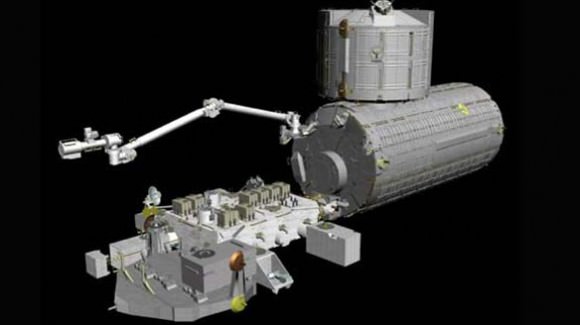
Endeavour’s crew will install the porch, which is actually a platform for one end of the Kibo laboratory on the station. The platform will hold experiments designed to work outside the protective confines of the station, exposing them to the space environment.
Mark Polansky (follow him on Twitter at Astro_127) will command the shuttle for STS-127. Douglas Hurley will serve as the pilot. Mission specialists are Christopher Cassidy, Thomas Marshburn, David Wolf and Julie Payette, a Canadian Space Agency astronaut.
Also flying along is Timothy Kopra, who will stay on at the ISS as a flight engineer and science officer, while current ISS resident and Japanese astronaut Koichi Wakata will return to Earth.
This will be a banner flight for all the international partners, as all five space agencies – the United States, the Russian, the Canadian, the Japanese and the European – will have representatives at the space station when the shuttle arrives, in addition to the six extra Americans and one extra Canadian Endeavour will carry. Polansky said just having all those nations represented and working together toward common goals is a huge accomplishment.
“I don’t think that, as a global community, we get the credit we should for doing something like that and what it means to set that kind of example,” he said. “Countries that have, historically, had a lot of differences and even today have some tensions, politically – when it comes to the arena of space, we’re somehow insulated from all that. On our level, it’s simply figuring out how to get the job done. And it’s not just a job like you’re constructing some building here on Earth. You’re doing something in an extremely hostile environment.”
The two crews will be extremely busy during the 16 day mission, so don’t expect to see them sitting back and relax on the front porch.
If you want to watch the launch preparations on NASA TV, the crew will strap into Endeavour about 4:00 am EDT on Saturday.
NASA’s Shuttle Program Hands Over Launch Pad to Constellation
[/caption]
It’s the end of an era, as Launch Pad 39B at Kennedy Space Center has been officially handed over to the Constellation Program. The handover took place Sunday after space shuttle Endeavour was moved to Launch Pad 39A. The ground operations team will finish modifying pad B for in time for first flight test of the Ares I-X rocket, currently scheduled for around August 30 of this year. Modifications will include removing the orbiter access arm and a section of the gaseous oxygen vent arm and installing access platforms and a vehicle stabilization system.
Since the late 1960s, pad B has been instrumental in human spaceflight programs. Originally, the pad was built for the Saturn V rockets for the Apollo flights to the moon, as well as flights to launch the Skylab space station and to send three crews to live on board. It also saw the launch of the Apollo spacecraft that was part of the Apollo Soyuz test program, where spacecraft from the US and USSR docked in space. In the 1980’s the pad was refitted for the space shuttle. Pad 39B was not ready until 1986, and the first Shuttle launch to use it was the ill-fated STS 51-L flight – the Challenger Disaster.
But now it’s time for the next generation of spacecraft and launch system. The Constellation Program is developing the Ares I and Ares V launch vehicles, the Orion crew capsule, and the Altair lunar lander — to carry humans to the International Space Station, the moon and beyond.
Spaceships on the Move!
[/caption]
Atlantis has begun her journey back home to the Kennedy Space Center, hitching a ride on the Shuttle Carrier Aircraft, a modified Boeing 747. The flight took off at about 11:05 EDT on Monday morning from Edwards Air Force Base, and the duo will fly to Biggs Army Air Field in El Paso, Texas and spend the night there before resuming the cross-country trip on Tuesday. Of course, Atlantis just returned from space, landing at Edwards on May 24, concluding the STS-125 mission to service the Hubble Space Telescope for the last time. Track the flight here.
But Atlantis isn’t the only spacecraft on the move. The shuttle Endeavour just rolled around to launchpad 39A, after standing down from its potential rescue mission, (STS-400) in case Atlantis was unable to return home, and now is preparing for the STS-127, which will hopefully launch around June 13. Watch the video of the rollaround below. And the next missions to the Moon are now poised for launch.
On May 28, the Lunar Reconnaissaince Orbiter and the Lunar Crater Observation and Sensing Satellitespacecraft were transported to the launch pad. The transport of the stacked and encapsulated LRO/LCROSS payload began at about 2 am local time and culminated with the attachment of the payload atop the Atlas AV-20 rocket at about 9:30am.
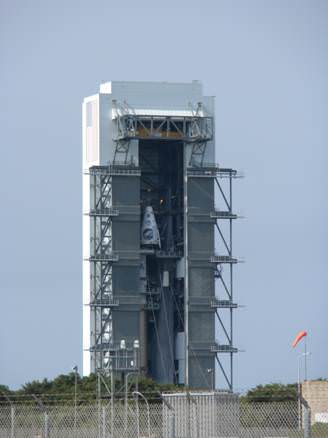
The spacecraft will launch together June 17 from Cape Canaveral Air Force Station in Florida.
Using a suite of seven instruments, LRO will help identify safe landing sites for future human explorers, locate potential resources, characterize the radiation environment and test new technology. LCROSS will seek a definitive answer about the presence of water ice at the lunar poles. LCROSS will use the spent second stage Atlas Centaur rocket in an unprecedented way that will culminate with two spectacular impacts on the moon’s surface.
New Era for ISS Begins As Crew Size Doubles
[/caption]
Three astronauts set to launch on a Soyuz rocket will bring a new era to the International Space Station by doubling the permanent crew size. Also, for the first time all the ISS partners will be represented on board the station at once as astronauts from NASA, CSA, ESA, JAXA and Russia will be part of the first six-person permanent crew. Liftoff is scheduled for 4:34 p.m. local time (1034 GMT; 0634 EDT) Wednesday from Russia’s Baikonur cosmodrome in Kazakhstan. The Soyuz TMA-15 capsule is expected to dock with the space station about two days later.
On board the Soyuz will be a truly international contingent, with Canadian astronaut Bob Thirsk, Russian cosmonaut Roman Romanenko, and Belgium’s Frank De Winne. They will join the current crew of the orbiting laboratory: Russia’s Gennady Padalka, U.S. astronaut Michael Barratt and Japan’s Koichi Wakata.
Thirsk called the expansion from a three-person to a six-person crew a “milestone” and said one of their goals was “to prove the station can support six people for a long duration.”
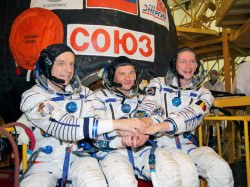
“This is the most international crew we’ve ever had” said Courtenay McMillan, Expedition 20 lead flight director. “It opens up a lot more possibilities and lets us schedule more science. We also have a lot more maintenance activities that can be done. Having six people on board does present a bit of challenge in communications with the ground, as we have twice as many people but no more ‘phone lines’, but folks are getting creative. We’ve learned a lot from the handover periods.”
A current crew of three typically has only about 20 hours a week to devote to science, but with six crew members, ISS officials hope to nearly triple the amount of time spent on science experiments. “This is a big transition from where we have been short on time. Now we have time,” said McMillan. “The crew has been very active in working with science community, ground control teams and to take advantage of the time we have.” McMillan added that the crew will have the ability to do not just new science, but doing additional runs on science that is up on board the station now.”
The last few shuttle missions to the ISS and Progress re-supply ships have been bringing up enough supplies to accommodate the increase in crew size. Now that the urine recycling system is working well, food is the biggest consumable the crews have had to stockpile.
“We have good margins on consumables,” said McMillan. ” We’ve piled up more margin than we usually do, to protect against flight slips. NASA said there is enough supplies on board that the crew could have enough to eat though October, even if no shuttles or Russian ships made it to the station. However two shuttle missions and two Soyuz capsules are scheduled to arrive at the station before the end of October.
UT Briefs: Shuttle Lands, Re-living Phoenix
[/caption]
Space Shuttle Lands
Space shuttle Atlantis landed safely in California on Sunday morning after “dynamic and unpredictable” weather kept the orbiter from returning to Florida. Atlantis touched down on runway 22 of Edwards Air Force Base at 11:39 am EDT (1539 GMT) Sunday, the first of two opportunities to land the shuttle in California. Atlantis spent nearly 13 days in orbit on the STS-125 mission, successfully repairing and upgrading the Hubble Space Telescope during a series of five spacewalks. Atlantis will be ferried to Kennedy Space Center on top of a modified 747 in about a week. Next shuttle mission: STS-127, slated for liftoff on June 13, on a trip to the International Space Station.
Remembering Phoenix
Do you remember what you were doing a year ago? You may recall the Phoenix Mars lander touched down on the Red Planet a year ago, and if you were on Twitter back then, you could follow the spacecraft’s progress via the fledgling social networking device. The “voice” of Phoenix’s Twitter account, Veronica McGregor, is re-living the events of a year ago by re-posting her “Tweets” in real time as they were written a year ago. It is a fun way to stroll down memory lane.
Bolden Nominated as NASA Administrator; Shuttle Landing Delayed
[/caption]
About the same time space shuttle Atlantis’ landing was waved off today due to continued rainy weather in Florida, the White House announced that former shuttle commander Charles Bolden Jr. will be nominated as NASA’s next administrator. President Obama also chose Lori Garver to be Bolden’s deputy administrator. Obama said, “These talented individuals will help put NASA on course to boldly push the boundaries of science, aeronautics and exploration in the 21st century and ensure the long-term vibrancy of America’s space program.”
Several different sources expect Bolden to be a strong proponent of manned spaceflight, since he has flown on the shuttle four times, with over 680 hours in space. Many believe he will also be strongly in favor of the Constellation program, as well as support the efforts of some members of Congress who would like to see the life of the space shuttle extended beyond 2010.
Bolden and Garver will have to be approved by Congress, which can sometimes be a lengty process. Let’s hope not – over four months without an official administrator is long enough.
Bolden will have his work cut out for him, as NASA has a lot on its plate, but no real growth in its budget. The fiscal year 2010 budget request of $18.686 billion includes $456M increase for science and $630M increase for Exploration. Some of that increase is because of the one-time Recovery Act stimulus money. Future budget proposals for fiscal years 2011, 2012, 2013 also are also relatively flat. NASA Watch.com reported several sources say Bolden expressed concern at his meeting with President Obama because he was told that further cuts to human spaceflight in future budgets might be needed.

Meanwhile, the crew of STS-125 will stay on orbit another day. NASA officials are still hoping the shuttle can land at Kennedy Space Center in Florida rather than Edwards Air Force Base in California.
The astronauts will have two opportunities to land in Florida Sunday and two at Edwards. The first Florida opportunity, the astronauts would fire Atlantis’ twin braking rockets at 8:58 am EDT with landing at 10:11 am. A second Florida landing opportunity is available at 11:49 am.
Friday’s landing attempt was also canceled because of rain, low clouds and lightning. The forecast for Sunday is marginal, with clouds and rain expected, but flight controllers are hopeful conditions will improve.
More Stunning Images From the Hubble Servicing Mission

In our last installment of images from the STS-125 mission, we left off with third EVA of the mission. Since then, as I’m sure you know, the astronauts have completed two more EVAs, released Hubble and are waiting for the weather to improve in Florida so they can land. So, let’s get caught up with the latest images released by NASA. I love the image above, as it has everything in it about the mission: two spacewalking astronauts from EVA #4 (Mike Massimino and Mike Good), the shuttle Atlantis, Hubble, and a beautiful view of Earth.
Continue reading “More Stunning Images From the Hubble Servicing Mission”
Weather Keeps Shuttle Crew in Space Another Day
STS-125 crew members aboard Atlantis (pictured above) will hang out at least a day longer in space, following foul weather that prevented a timely landing today at NASA’s Kennedy Space Center in Florida.
And the forecast isn’t looking any sunnier for at least a little while.
There’s a 70 percent likelihood that storms will stick around today, with that chance dropping slightly to 60 percent through Saturday. By early next week, the chance of thunderstorms will have dropped below 50 percent.
NASA Flight Director Norm Knight and the entry team will evaluate weather conditions at Kennedy before permitting Atlantis and its crew to land at 9:16 a.m. Saturday. A second Kennedy landing opportunity is at 10:54 a.m. The shuttle also has landing opportunities at Edwards Air Force Base in California at 10:46 a.m. and 12:24 p.m.
If Atlantis does not land Saturday, there are multiple landing opportunities Sunday at Kennedy, Edwards, or White Sands Space Harbor in New Mexico.
Meanwhile, here are some ways to keep current on the mission’s finale:
NASA TV downlink information, including schedules and links to streaming video,
SRB Videos, A Toast to Recycled Urine and Other Misc. Spaceflight Notes
It has been a busy day in space and here are a few jottings about what all has been going on. Above, you can watch the spectacular videos taken by cameras mounted on the shuttle’s solid rocket boosters, taken during the launch of Atlantis on the current Hubble Servicing Mission. It’s a crazy ride, tagging along on the outside of the shuttle going up, and spinning dizzily on the way down until splashing in the ocean. Not for the faint of heart! But seeing the SRB videos means only one thing: Atlantis and the STS-125 crew have been cleared to land. NASA has carefully reviewed the videos and the data from the crew’s scan of the shuttle’s thermal protection system, saying there are absolutely no issues that would preclude the shuttle from landing. Weather, however could be another matter, which is why NASA ordered the shuttle to power down for awhile today to save on consumables. Predicted weather does not look good for landing on Friday, so the crew will make sure they have enough power to stay in orbit for a few more days.
Now about that toast…
[/caption]
A huge crowd gathered in the space station mission control room at Johnson Space Center today as the ISS crew was given a “go” to drink water that the new recycling system has purified. Everyone joined in at mission control with a toast to the success of the recycling system, giving a nod to everyone who helped create the system, install it on the ISS and work on getting the fussy system to run. This is big news, as it means the station is ready to handle the increased crew size of 6 astronauts.
Also:
The STS-125 crew held a press conference from the shuttle today. The highlight was Mike Massimino talking about how he ripped a handrail off of Hubble in order to proceed with the scheduled repair of the STIS instrument.
“Ripping that thing out of there was quite an experience, and I’m glad it led to a successful repair,” said Massimino, who added that he drew inspiration from his uncle Frank, who once ripped an oil filter out a car. “That was pretty close to what was going on with Hubble.”
Later, during a ship-to-ship call between Atlantis and the ISS, space station crew member Michael Barrett revisited Massimino’s special touch.
“The magic Massimino touch is now legendary, and we’re looking forward to seeing you guys back on the ground,” he said.
If you missed the crew news conference, its available here. Additionally, the discussion between the two crews, can be seen here.
Update: One other piece of news from the shuttle is that President Obama called the STS-125 crew to congratulate them on a job well done. “I wanted to personally tell you how proud I am of all of you and everything that you’ve accomplished,” he said.
“Like a lot of Americans, I’ve been watching with amazement the gorgeous images you’ve been sending back and the incredible repair mission you’ve been making in space,” he said. “I think you’re providing a wonderful example of the kind of dedication and commitment to exploration that represents America and the space program generally. These are traits that have always made this country strong and all of you personify them.”
Obama also said he would be naming a new NASA administrator very soon, but wouldn’t say who it is.
“Just so we’re sure, the new administrator is not any of us on the flight deck right now, is it?” asked Commander Scott Altman (Altman had suggested Hubble fix-it man John Grunsfeld for administrator earlier this week.)
“I’m not going to give you any hints,” Obama said with a laugh.
“Thank you very much, fair enough, sir,” Altman replied.
Listen to the audio and/or read the transcript of Obama’s call here.
One other spaceflight news tidbit, Orbital Sciences Corp. finally launched a Minotaur 1 rocket from the Wallops Island Flight Facility with the Tactical Satellite-3 (TacSat-3) satellite. The launch was heavily postponed, with several scrubs relating from the weather to the launch vehicle and facility. Find out more about the launch and the satellite here.


